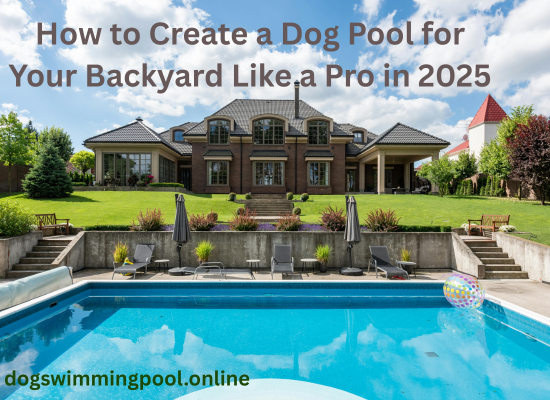Create a durable and safe dog pool to keep your pup cool and happy in the summer. Choose the right materials, pick the best location, and follow proper water maintenance to ensure a hassle-free, fun experience!
Last summer, I watched my golden retriever, Max, turn a $20 kiddie pool into confetti in under an hour. Frustrated, I dove into researching durable, dog-friendly pools—and discovered a world of options I never knew existed. Whether you’re battling heatwaves or a hyperactive pup, a backyard dog pool isn’t just a luxury; it’s a game-changer. Let’s break down how to nail this project without wasting time or money.

Why a Dog Pool Matters in 2025
Backyard dog pools are exploding in popularity, and for good reason. A 2024 American Pet Products Association survey revealed that 68% of pet owners now prioritize “pet-specific outdoor spaces.” But it’s not just about splashing around.
Read more: The Complete Guide to Swimming Pool Dog Jackets: Key Features and Benefits
- Safety First: Overheating causes 15% of emergency vet visits in summer (ASPCA).
- Mental Stimulation: Veterinarian Dr. Lisa Kim notes, “Water play reduces anxiety in 80% of high-energy dogs.”
- Bonding Boost: My neighbor Sarah swears her rescue pitbull’s pool time helped them build trust.
7 Costly Mistakes to Avoid When Installing a Dog Pool
- Choosing the Wrong Material: Inflatable Pools? Cue Max’s shredding spree. Opt for reinforced PVC or galvanized steel.
- Ignoring Slip Resistance: Smooth surfaces = wiped-out pups. Textured liners or rubber mats are lifesavers.
- Poor Placement: Direct sunlight breeds algae. Partial shade + easy drainage = smarter setup.
- Skipping the “Paw-clarity Test”: Not all dogs love water. Start shallow—I learned this with my timid dachshund, Luna.
- Forgetting Maintenance: Stagnant water attracts mosquitoes. A $30 filter keeps it fresh.
- Overcomplicating Design: Custom pools can hit 2k.Start simple,likethisDIYcinder−blockpoolIbuiltforunder2k. Start simple,likethisDIYcinder−blockpoolIbuiltforunder300.
- Neglecting Safety Exits: Ramps or steps prevent panic. Trust me—watching a soggy corgi struggle to climb out is heart-wrenching.
My Step-by-Step System for Dog Pool Success

Step 1: Size It Right
- Small dogs: 4’x2’ (think: portable plastic pools).
- Large breeds: 8’x3’ with a depth of 12–18 inches.
Step 2: Location, Location, Location
- Avoid tree roots (they puncture liners).
- Use a $7 level tool to ensure even ground.
Step 3: Safety Upgrades
- Non-slip spray ($20 on Amazon) + a collapsible ramp.
- Shade sail ($45) to block UV rays.
Step 4: Water Rules
- Refill every 2–3 days. Add a pet-safe water clarifier.
- Pro Tip: Use a kiddie pool heater in the fall—it extends swim season by weeks!
Step 5: Introduce Gradually
Conclusion
A backyard dog pool isn’t just a summer splurge—it’s an investment in your pup’s health and happiness. Start small, prioritize safety, and don’t be afraid to get creative (my friend repurposed a livestock trough!). Drop a comment with your dog’s first pool reaction—or share a photo of your setup!
Read more: The Ultimate Dog Pool: The Complete Guide to Keeping Your Dog Cool and Entertained
FAQS
1. Are dog pools safe for puppies?
Yes, but supervise closely. Use shallow water (ankle-deep) and avoid harsh chemicals.
2. How do I winterize a dog pool?
Drain fully, scrub with vinegar, and store upside down. For permanent pools, use a frost-proof cover.
3. Can I use my existing pool?
Human pools work, but chlorine irritates paws. Rinse dogs post-swim and check pH levels weekly.